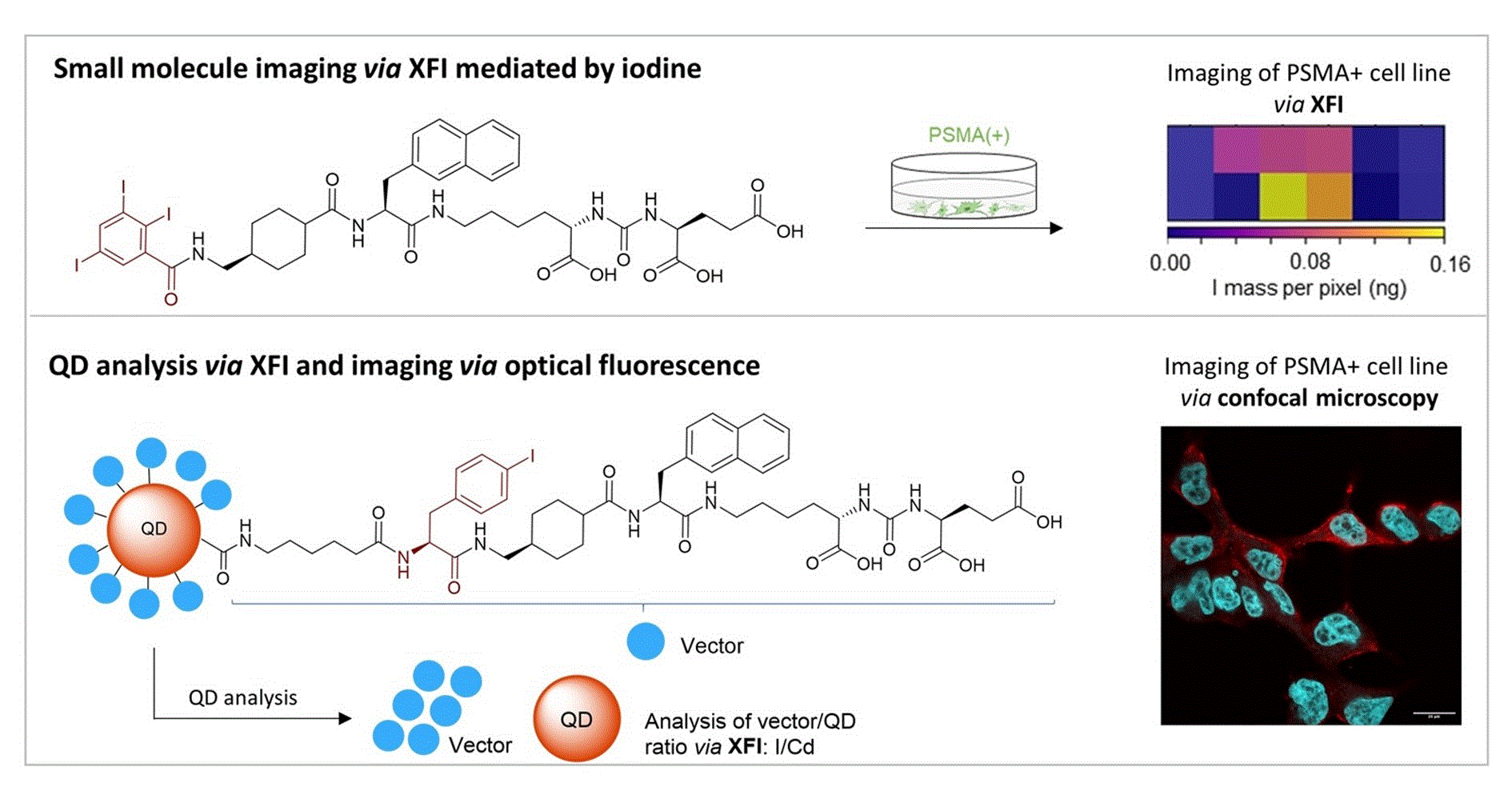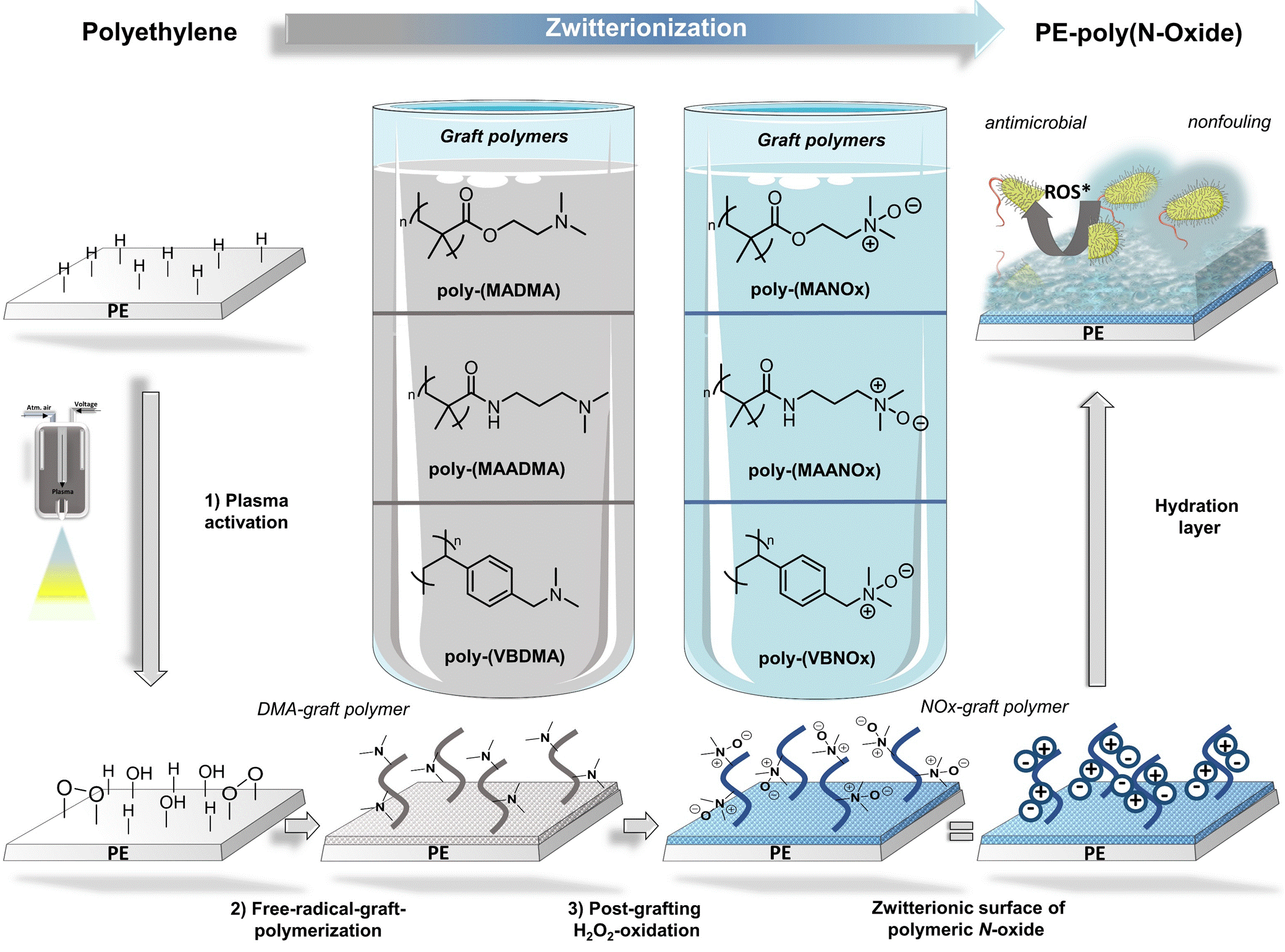Forschung
Research activities in the Maison group are focused on 3 major areas:
Disease imaging

1. Chemical Tools for Prostate Cancer Imaging

Prostate cancer has the second highest incidence of all cancers in men, with an estimated 1.3 million new cases worldwide and 360 000 associated deaths in 2019. In contrast to the high incidence, standard diagnostic tools such as digital rectal exam or the prostate-specific antigen (PSA)-test are rather imprecise. In this context, the membrane protein PSMA is one of the most promising tumor markers for prostate cancer and is currently used for targeted applications in a clinical context. Modern targeted tracers consist of two building blocks: the effector molecule for imaging and/or therapeutic application, and the targeting ligand needed to bind the tumor marker with high affinity and specificity. We develop new targeted tracers for PSMA suitable for high-resolution methods such as PET, XFI and fluorescence imaging. Our work involves the synthesis of targeted tracers, the investigation of their pharmacokinetic properties and their targeting efficiency in cells.
Further reading:
- Holzapfel, M.; Mutas, M.; Chandralingam, S.; von Salisch, C.; Peric, N.; Segelke, T.; Fischer, M.; Chakraborty, I.; Parak, W. J.; Frangioni, J. V.; Maison, W., Nonradioactive Cell Assay for the Evaluation of Modular Prostate-Specific Membrane Antigen Targeting Ligands via Inductively Coupled Plasma Mass Spectrometry. J. Med. Chem. 2019, 62, 10912-10918. DOI: 10.1021/acs.jmedchem.9b01606
- Schmutzler, O.; Graf, S.; Behm, N.; Mansour, W. Y.; Blumendorf, F.; Staufer, T.; Körnig, C.; Salah, D.; Kang, Y.; Peters, J. N.; Liu, Y.; Feliu, N.; Parak, W. J.; Burkhardt, A.; Gargioni, E.; Gennis, S.; Chandralingam, S.; Höeg, F.; Maison, W.; Rothkamm, K.; Schulz, F.; Grüner, F., X-ray Fluorescence Uptake Measurement of Functionalized Gold Nanoparticles in Tumor Cell Microsamples. Int. J. Mol. Sci. 2021, 22, 3691. DOI:10.3390/ijms22073691
- Höeg, F.; Schulz, J.; Graf, S.; Salah, D.; Chandralingam, S.; Maison, W.; Parak, W. J.; Schulz, F., Defined Coadsorption of Prostate Cancer Targeting Ligands and PEG on Gold Nanoparticles for Significantly Reduced Protein Adsorption in Cell Media. J. Phys. Chem. C 2022, 126, 20594-20604. DOI: 10.1021/acs.jpcc.2c05415
- Kerpa, S.; Holzapfel, M.; Staufer, T.; Kuhrwahl, R.; Mutas, M.; Werner, S.; Schulze, V. R.; Nakielski, P.; Feliu, N.; Oetjen, E.; et al. Iodinated PSMA Ligands as XFI Tracers for Targeted Cell Imaging and Characterization of Nanoparticles. International Journal of Molecular Sciences 2024, 25. DOI: 10.3390/ijms252211880.
2. Gd- and Mn-based Contrast Agents for MRI

High complex stability and longitudinal relaxivity of Gd-based contrast agents are important requirements for magnetic resonance imaging (MRI) because they ensure patient safety and contribute to measurement sensitivity. Charged and zwitterionic Gd3+-complexes of the well-known chelator 1,4,7,10-tetraazacyclododecane-1,4,7,10-tetraacetic acid (DOTA) provide an excellent basis for the development of safe and sensitive contrast agents. We investigate charged and zwitterionic Gd-DOTA complexes and the influence of hydration and complex geometry on pharmacokinetics and the T1-relaxivity of these reagents. Both parameters are extremely important to improve the sensitivity of MRI measurements.
Further reading:
- Kerpa, S.; Schulze, V. R.; Holzapfel, M.; Cvancar, L.; Fischer, M.; Maison, W., Decoration of 1,4,7,10-tetraazacyclododecane-1,4,7,10-tetraacetic acid (DOTA) with N-oxides increases the T(1) relaxivity of Gd-complexes. ChemistryOpen 2024, e202300298. DOI: 10.1002/open.202300298
- Holzapfel, M.; Baldau, T.; Kerpa, S.; Guadalupi, G.; Qi, B.; Liu, Y.; Parak, W. J.; Maison, W., Solution Structure and Relaxivity of Ln-DOTXAZA Derivatives. Eur. J. Inorg. Chem. 2022, 2022, e202200432. DOI: 10.1002/ejic.202200432
3. Chemical Optimization of 89ZR-chelators

89Zr has a number of advantageous properties for PET-imaging, but optimal chelators for its widespread clinical application still need to be found. Tetrahydroxamates derived from the natural siderophore DFOB are promising candidates in this context. We develop isopeptidic analogues of DFOB termed ipDFO* and investigate the impact of backbone structure and denticity on the chelation of Zr. The studies include the solid phase synthesis of chelators, structural characterization of complexes and the evaluation of complex stabilities in biological media. Clickable derivatives AZA-ipDFO* are of particular interest for optimization of pharmacokinetic properties and/or the conjugation of targeting vectors for diseases.
In addition, we investigate the impact of hydroxamate spacing in ipDFO-derivatives on the chelation properties of other oxophilic metals.
Further reading:
- Outzen, L.; Nguyen, H. D.; Ludolfs, D.; Maison, W., Mixed Liquid and Solid Phase Synthesis of Isopeptidic Desferrioxamine Analogues for Complexation of Zirconium. European Journal of Organic Chemistry 2024, e202400266. DOI: 10.1002/ejoc.202400266
- Outzen, L.; Munzmay, M.; Frangioni, J. V.; Maison, W., Synthesis of Modular Desferrioxamine Analogues and Evaluation of Zwitterionic Derivatives for Zirconium Complexation. ChemMedChem 2023, e202300112. DOI: 10.1002/cmdc.202300112
- Outzen, L.; Ludolfs, D.; Irl, M.; Kossatz, S.; Maison, W. Isopeptidic Desferrioxamine Analogues: The Role of Hydroxamate Spacing for Chelation of Zr(4). ChemMedChem 2024, e202400890. DOI: 10.1002/cmdc.202400890
Antibacterial and Low-fouling Materials

1. Zwitterionic and Highly Charged Polymer Brushes on Bulk plastics

Microbial biofilms are formed on almost any type of material exposed to biological media. They are of fundamental importance in nature and have implications for many industrial processes, the food and the health sector. For in vivo applications, the adhesion of biomolecules to surfaces contributes to immunogenicity and low blood compatibility. The chemical modification of base materials such as glass, plastics, and metals by surface-initiated graft polymerization is an efficient approach to prevent the formation of biofilms. We develop green protocols such as plasma or light mediated modification of plastics with highly charged and zwitterionic polymers. The resulting materials have either antibacterial and/or low-fouling properties and are valuable for a range of applications in the health and food sector. Our work includes the synthesis of charged monomers and their graft polymerization from bulk plastics such as PE, PP, PU, PA and rubber. We investigate the surface properties of the resulting materials on a molecular level and evaluate their interaction with microorganisms. A particular focus of our research is the use of zwitterions and N-oxides for surface modification. We study their chemical reactivity and their interaction with biological matter.
Further reading:
- Kliewer, S.; Wicha, S. G.; Broker, A.; Naundorf, T.; Catmadim, T.; Oellingrath, E. K.; Rohnke, M.; Streit, W. R.; Vollstedt, C.; Kipphardt, H.; Maison, W., Contact-active antibacterial polyethylene foils via atmospheric air plasma induced polymerisation of quaternary ammonium salts. Colloids Surf., B 2020, 186, 110679. DOI: 10.1016/j.colsurfb.2019.110679
- Burmeister, N.; Zorn, E.; Preuss, L.; Timm, D.; Scharnagl, N.; Rohnke, M.; Wicha, S. G.; Streit, W. R.; Maison, W., Low-Fouling and Antibacterial Polymer Brushes via Surface-Initiated Polymerization of a Mixed Zwitterionic and Cationic Monomer. Langmuir 2023, 39, 17959-17971. DOI: 10.1021/acs.langmuir.3c02657
- Burmeister, N.; Zorn, E.; Farooq, A.; Preuss, L.; Vollstedt, C.; Friedrich, T.; Mantel, T.; Scharnagl, N.; Rohnke, M.; Ernst, M.; Wicha, S. G.; Streit, W. R.; Maison, W., Surface Grafted N‐Oxides have Low‐Fouling and Antibacterial Properties. Advanced Materials Interfaces 2023, 10, 2300505. DOI: 10.1002/admi.202300505
- Kobus, M.; Friedrich, T.; Zorn, E.; Burmeister, N.; Maison, W., Medicinal Chemistry of Drugs with N-Oxide Functionalities. J. Med. Chem. 2024, 67, 5168-5184. DOI: 10.1021/acs.jmedchem.4c00254
2. Zwitterionic and Highly Charged Polymer Brushes on Metals

Titanium and its alloys are widely used for the construction of light, biocompatible, and corrosion-resistant devices. In the biomedical field, it is a common implant material and is also used for surgical instruments or biosensors. In this context, the adhesion of bacteria to titanium surfaces and subsequent biofilm formation are major risk factors for healthcare acquired infections. Medical device infection, for example, is a major cause of orthopedic implant failure. We develop low-fouling and biocompatible polymer brushes, which are anchored covalently to the surface of metals via surface-initiated atom transfer radical polymerization (SI-ATRP) or surface-initiated photoiniferter-mediated polymerization (SI-PIMP). Our work includes the synthesis of bifunctional anchor molecules and reactive monomers for radical polymerization. We investigate the properties of highly charged surfaces on a molecular level by high-resolution analytics and study the interaction of these materials with biological matter.
Further reading:
- Zorn, E.; Knaack, J. I. H.; Burmeister, N.; Scharnagl, N.; Rohnke, M.; Wicha, S. G.; Maison, W., Contact-Biocide TiO(2) Surfaces by Surface-Initiated Atom Transfer Radical Polymerization with Chemically Stable Phosphonate Initiators. Langmuir 2023, 39, 11063-11072. DOI: 10.1021/acs.langmuir.3c01366
- Burmeister, N.; Zorn, E.; Preuss, L.; Timm, D.; Scharnagl, N.; Rohnke, M.; Wicha, S. G.; Streit, W. R.; Maison, W., Low-Fouling and Antibacterial Polymer Brushes via Surface-Initiated Polymerization of a Mixed Zwitterionic and Cationic Monomer. Langmuir 2023, 39, 17959-17971. DOI: 10.1021/acs.langmuir.3c02657
- Burmeister, N.; Zorn, E.; Farooq, A.; Preuss, L.; Vollstedt, C.; Friedrich, T.; Mantel, T.; Scharnagl, N.; Rohnke, M.; Ernst, M.; Wicha, S. G.; Streit, W. R.; Maison, W., Surface Grafted N‐Oxides have Low‐Fouling and Antibacterial Properties. Advanced Materials Interfaces 2023, 10, 2300505. DOI: 10.1002/admi.202300505
Corrosion Protection of Metals


Corrosion-induced damage poses high security risks, not only in manufacturing processes, buildings etc. but also in implant medicine. Small molecules and polymers preventing corrosion have therefore a major role in corrosion protection. Depending on the field of application, various compounds with anti-corrosive properties for various metals have been used. The criteria for selection of these corrosion inhibitors have changed significantly in the last decades, and are today not only performance-driven, but influenced by ecological considerations, toxicity and regulatory standards. We develop green corrosion inhibitors for iron, steel, Cu and Mg based on natural products such as terpenes, amino acids or sugars. Our work includes the synthesis of corrosion inhibitors with green protocols and their detailed evaluation in physiological and non-physiological media. A particular focus of our work is the electrochemical evaluation of corrosion inhibitors and additives.
Further reading:
- Ruf, E.; Naundorf, T.; Seddig, T.; Kipphardt, H.; Maison, W., Natural Product-Derived Phosphonic Acids as Corrosion Inhibitors for Iron and Steel. Molecules 2022, 27, 1778. DOI:10.3390/molecules27061778
- Naundorf, T.; Seddig, T.; Ruf, E.; Ballentin, L.; Kipphardt, H.; Maison, W., Alkali salts of amino acids as alkaline additives for neutralization of acidic corrosion inhibitors. Amino Acids 2023, 55, 665-678. DOI: 10.1007/s00726-023-03260-x
- Seddig, T.; Naundorf, T.; Kipphardt, H.; Maison, W., Glucamines as green alternatives to conventional amino alcohols in metalworking fluids. Mater. Corros. 2023, 74, 394-402. DOI: 10.1002/maco.202213406
